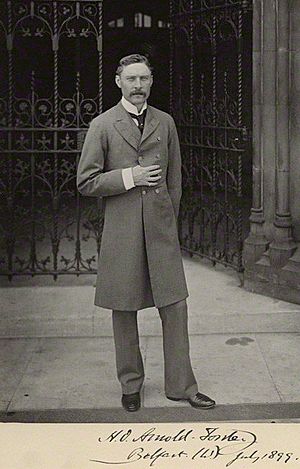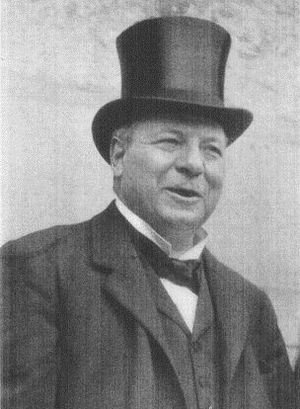Territorial and Reserve Forces Act 1907 facts for kids
| Act of Parliament | |
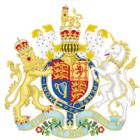
|
|
| Long title | An Act to provide for the reorganisation of His Majesty's Military Forces and for that purpose to authorise the establishment of County Associations, and the raising and maintenance of a Territorial Force, and for amending the Acts relating to the Reserve Forces. |
|---|---|
| Citation | 7 Edw. 7. c. 9 |
| Introduced by | Richard Haldane |
| Territorial extent | England and Wales, Scotland, Ireland |
| Dates | |
| Royal assent | 2 August 1907 |
| Other legislation | |
| Repealed by | Statute Law Revision Act 1966 |
|
Status: Repealed
|
|
The Territorial and Reserve Forces Act 1907 was an important law passed by the Parliament of the United Kingdom. It changed how the British Army's part-time forces were organized.
Before this Act, there were three main groups of part-time soldiers: the Militia, the Volunteers, and the Yeomanry. This Act created a new group called the Territorial Force (TF) from the Volunteers and Yeomanry. It also got rid of the Militia and created a new Special Reserve for the main army.
These changes were a big part of the Haldane Reforms. They were named after Richard Haldane, who was the person who created this Act.
The idea for these changes came from lessons learned during the South African War (1899-1902). This war showed that the main British Army wasn't big enough to fight a long war on its own. Almost all regular soldiers in the UK had to go overseas very quickly. Also, the army's reserves ran out within a year. Before this war, no one really thought about sending part-time forces overseas. But during the war, they had to use volunteers in new ways. It became clear that a better system was needed for the future.
After some failed attempts at reform by the previous government, the Liberal Party won the election in 1905. Richard Haldane became the Secretary of State for War. He immediately started to reorganize the army. His goal was to get it ready for a possible war in Europe. He planned for a main "Expeditionary Force" and a "Territorial Force" as a backup. He also wanted a bigger reserve for the main army.
Haldane worked hard to get his new law passed. He talked with senior army officers, the King, and even the leader of the opposition party. This helped him get support for his ideas.
However, some groups were against his plan. One group, led by Field Marshal Lord Roberts, thought that part-time forces would not be strong enough against other European armies. They even wanted compulsory military service for everyone. The Labour Party generally didn't want to increase military strength. Also, some people who liked the old system, especially the Militia, were against the changes.
Haldane made some small changes to the law before presenting it in March 1907. For example, he said that compulsory service would only be for defending the home country. Even so, the new Territorial Force was designed to be very large. It included all the support units needed for 14 full divisions. Haldane hinted that these forces "could go abroad if they wish." The law was debated in Parliament and passed easily. It became official in August 1907, with most changes starting on April 1, 1908.
The Act had three main parts. The first part created "County Associations." These were local groups that would manage and support the new Territorial units. They would not control them during military service. The second part changed the existing Volunteers and Yeomanry into the new Territorial Force. The third part ended the Militia and created the Special Reserve. This new reserve was for men who had not served in the main army before.
Contents
Why the Army Needed to Change
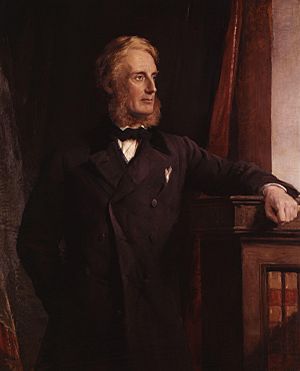
In 1899, the British Army had to send a large number of soldiers overseas for the South African War. This was the first big overseas deployment since the 1850s. Before this, the army had made many changes. The Cardwell Reforms (1868–1872) made officers more professional. They also changed how soldiers joined the army. Soldiers would serve for six years and then be available as reserves for another six years. This new reserve system was tested in later conflicts.
The army's organization was also improved. Regular army regiments were linked with local militia and volunteer units. Later, the Childers Reforms formally combined these groups. This meant that usually, one battalion of each infantry regiment stayed home. The other battalion was overseas. This way, about half of the main army was always ready in the United Kingdom. It was thought that if the whole army was called up, it could provide two full army corps of regular troops. A third corps would be a mix of regulars and militia. The other part-time forces would defend ports and London.
Part-Time Forces in 1899
The main army was supported by three "auxiliary forces": the Militia, the Yeomanry, and the Volunteers.
- The Militia was managed by the main army. Recruits trained for six weeks when they joined and then one month each year. This worked for farm workers but not for city workers. Many young men from the Militia joined the main army. About 20% served their full six years. Militiamen over 19 could join the Militia Reserve. This meant they agreed to serve overseas with the regular army if needed. The Militia had many infantry battalions and coastal artillery units. But it had very few support units. It was more like a collection of separate units than a strong home defense force.
- The Yeomanry were 38 regiments of volunteer cavalry. Historically, they helped keep order and stop local riots. Their recruits were usually wealthy and often paid for their own horses and uniforms. Training was light, with an eight-day camp each year. They were ready to defend against invasion or rebellion. But they were not prepared for quick mobilization. They had no transport or supply officers.
- The Volunteers were mostly small business owners, skilled workers, and professionals. They were mainly city-based units. They trained on weekends and usually had no annual camp. They had many rifle and artillery units. But most artillery was for coastal defense. They did not form an organized fighting force. They also had some engineer and medical units, but no service corps. Volunteer units were often supported by local donations and their commanders.
How the South African War Changed Things
The reforms had created a large force of regular troops in the UK. This force was meant to be sent overseas. But when the decision was made to send a large force to the South African War, the system struggled. Three army divisions were planned for deployment in October 1899. About 25,000 reservists were called up to join them. However, many soldiers under 20 could not go overseas. So, reservists had to replace them and fill other gaps. In some units, over half the soldiers were reservists. Overall, 36.5% of men were not fit for foreign service.
When the force sailed, 20,000 of 47,000 men were reservists. More divisions were organized quickly. By the end of January, a seventh division was sent. This left the country with almost no regular troops.
Before the war, no one had planned to send the Militia, Yeomanry, or Volunteers overseas as full units. About 43,000 reservists went overseas with the regular forces. The rest were sent later as replacements. By September 1900, the reserve system had completely run out of men.
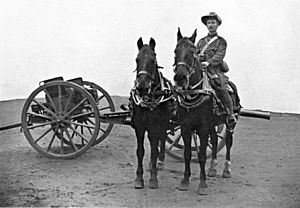
In December, the first request for part-time troops came from South Africa. Many Militia battalions volunteered and were sent overseas. Sixty battalions went to South Africa, and eight more served in other colonies. They mostly worked on supply lines. They were seen as lower quality troops. This was because they lacked officers and had many young, inexperienced soldiers. Many of their best men had joined the Militia Reserve and were sent to regular units.
The first Volunteer unit sent was the City Imperial Volunteers from London. They were sent to combat after six weeks of training in South Africa. Lord Roberts praised them as "quite excellent." Other volunteer companies were also formed and joined regular battalions. They were well-regarded in the field.
The Yeomanry were not used as full units either. They were trained as cavalry, but the war needed mounted infantry. So, a new force called the Imperial Yeomanry was created. Many officers and non-commissioned officers came from the Yeomanry. But most recruits were civilians. These units performed well.
Attempts at Reform by the Conservatives
After the election in 1900, the Conservative Party stayed in power. St. John Brodrick became the head of the War Office. He immediately called for big changes. He wanted to be ready to send three army corps (120,000 men) overseas at any time. He suggested dividing the country into six military districts. The first three corps would be for overseas service. The other three would be a mix of regular and part-time forces. The Yeomanry would also be greatly expanded.
This plan was slow to start. By March 1903, some corps were not yet formed. Many units were missing or in the wrong places. The First Corps even lacked commanders.
Later, Hugh Arnold-Forster became the War Secretary. He appointed a committee to reform the War Office. This led to the Esher Report in 1904, which suggested administrative changes. Also in 1904, the Norfolk Commission looked at the Militia and Volunteers. It suggested compulsory service, which the government quickly rejected. But it also offered other ideas that were later used in the Haldane Reforms. The report said the Militia was "unfit to take the field." It also said the Volunteer Force was "not qualified" to fight a regular army.
Arnold-Forster tried to split the Regular Army into two parts: one for service at home and overseas, and one for home service only. He also wanted to reduce the Volunteers. But his plans faced strong opposition and made little progress. Attempts to secretly identify Volunteer units to be disbanded were leaked to the newspapers. Arnold-Forster had to back down.
By the end of this period, the constant attempts at reorganization had caused problems for the part-time forces. The Militia was understrength and disorganized. The number of Volunteer recruits was falling, and their finances were worrying. Many Volunteer Corps were facing financial collapse.
Haldane Takes Charge
In December 1905, the government changed. Richard Haldane became Secretary of State for War. He quickly decided that the army needed to be efficient and save money. After an election, Haldane focused on how to prepare the army for a possible war in Europe. He realized there was a need for a regular "Expeditionary Force." This force would be specifically trained to fight in Europe.
Haldane planned for this force to have six infantry divisions with all their support units. They would be ready to mobilize quickly in the UK and go to Europe. He decided to change the army's structure. Instead of three parts (Regular Army, Volunteers/Yeomanry, Militia), it would have two: an Expeditionary Force and a much larger Territorial Force. The Territorial Force would be based on local County Associations. It would act as a second line of defense and support for the main army. It would have 14 divisions with all the necessary artillery, engineers, and medical support. It would also have 14 cavalry brigades. This force would be for home defense but could also expand the main army in a major war.
Haldane formed a committee to discuss his proposals. It included representatives from all parts of the army. But the committee struggled to agree, especially on what to do with the Militia. The Militia leaders wanted their units to serve overseas as complete battalions, not just send individual soldiers. Since both ideas for the Militia were opposed, Haldane decided to get rid of it entirely. He replaced it with a new force called the Special Reserve. This new reserve would include Militia members who agreed to transfer.
Haldane also faced strong opposition from other groups. The National Service League, led by Field Marshal Lord Roberts, argued that part-time forces would not be effective. They believed that compulsory military service was the only solution. The Labour Party generally opposed increasing military strength. Some volunteers also opposed being forced to serve overseas.
Because of these pressures, Haldane decided that the new law would only require compulsory service for home defense. However, he still designed the Territorial Force to be very large. It had 14 divisions with full support. This was a big force for just home defense. He still hinted that they "could go abroad if they wish." This change was a tactic to get the bill passed. His main goal remained the same.
How the Law Was Made
Haldane drafted the Act in late 1906 with help from others. He sent the final draft to the King in January. He was confident the Prime Minister would support it. He also talked privately with Arthur Balfour, the Leader of the Opposition. This helped ensure there wouldn't be much opposition from the Conservative Party.
The governing Liberal Party was busy with social reforms. It wasn't certain there would be time for a defense bill. But Haldane found that another bill wasn't ready. So, he offered his "small Bill" to fill the gap.
On February 25, Haldane introduced the new Army Estimates. These showed some cost savings. He talked about the upcoming reforms. He said the main problems were getting enough recruits for the main army from the Militia and supporting the Volunteer units financially. A memo issued that day said that if the Expeditionary Force went abroad, the Territorial Force would be mobilized for "support and expansion." After six months of training and home defense, they could volunteer for overseas service.
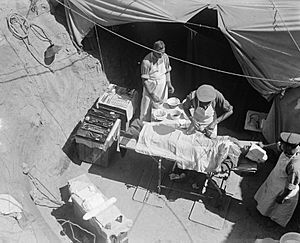
The bill was officially introduced to the House of Commons on March 4, 1907. The House of Lords debated it on March 21. They strongly opposed the changes to the Militia. The bill had its second reading in the Commons in April. It was then discussed in detail over nine days. The opposition was loud but not very effective. Hugh Arnold-Forster, the former War Secretary, argued that the Territorial Force would be useless against European armies. The Labour Party generally opposed any increase in military strength.
Most of the opposition came from people who liked the old system. Militia supporters were against the changes. Yeomanry supporters objected to cuts in their daily pay. Sir Howard Vincent led the Volunteers' opposition to the new, stricter rules. However, the strong Liberal majority easily defeated all opposition. The bill passed its third reading on June 19 with a large majority.
The bill then went to the House of Lords. They made a few small changes. One brief disagreement was about Cadet units. It was agreed that County Associations could support them. But no money from Parliament could be used for anyone under 16. This was a compromise. The bill then smoothly received Royal Assent.
What the Act Said
The Act had four main parts. Part I created the County Associations. Part II covered forming the Territorial Force from existing volunteers and yeomanry. Part III created the Special Reserve and transferred Militia units. Part IV had other miscellaneous rules.
Part I—County Associations
Part I allowed the creation of County Associations. The Army Council would create plans for these associations. They would be funded by the government but could also raise their own money. The Act clearly stated that these associations would not have military control over the forces they managed. These associations still exist today as Reserve Forces and Cadets Associations.
How Associations Were Organized
Section 1 of the Act said that County Associations would be in charge of reorganizing and managing the military forces, except for the main army and its reserves. The Army Council would create a plan for each association. This plan would define who its members were and its name. These plans had to be approved by Parliament.
The Act expected the lord-lieutenant of the county to be the president. At least half the members had to be officers from the Territorial Force. Members could also include representatives from local councils and universities. People representing employers and workers could also be included. Each association would cover one county. Large counties could be divided into smaller sub-associations.
What Associations Did
Section 2 of the Act listed the duties of County Associations. Their main job was to organize the Territorial Force in their county. But they were not allowed to train any part of the military forces. The Act allowed almost any relevant duties of the Crown to be given to the Associations. Some key duties included:
- Organizing and managing Territorial Force units, except when they were called for training or service.
- Recruiting for the Force in peacetime and wartime.
- Providing and maintaining rifle ranges, buildings, and camp sites. They also had to organize areas for training exercises and safely store weapons.
- Arranging with employers for holidays for training and setting training camp times.
- Setting up and supporting cadet battalions and rifle clubs. However, no government money could be used for anyone under 16.
- Providing horses for the Force's peacetime needs.
- Supplying mobilized Territorial units within the county.
- Paying allowances to families of men in the Force when called for service. They also cared for reservists and discharged soldiers.
Part II—The Territorial Force
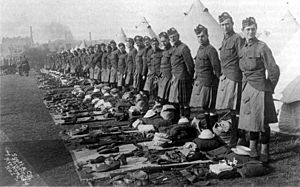
Part II of the Act allowed the creation of the Territorial Force. The Crown would make rules for its government, discipline, and pay. Any existing law that applied to the Militia, Yeomanry, or Volunteers could be extended to the Territorial Force.
Joining and Serving
Men would join the Force through a specific county association and as part of a specific unit. They could choose which unit if there were multiple. Like the main army, men could not be moved to another unit without their permission. Service periods were up to four years and could be extended. If the Force was called for permanent service, a man's service could be extended by up to 12 months. A member could buy their way out of service by giving three months' notice and paying up to five pounds. This was not allowed during times of active service. They could also be discharged for bad behavior.
New officers in the Territorial Force were recommended by the association president. They had to meet all the necessary requirements.
Besides regular drills, recruits had to attend annual training for 8 to 15 days a year (8 to 18 for cavalry). The Crown could extend this training up to 30 days or cancel it if needed.
The Act listed military offenses and their punishments. These included not showing up for service or training, and damaging government property. It also explained how offenses would be tried. Members of the Force could not be punished for missing time to vote in an election.
Members of the Force were excused from serving as police officers or on juries. Officers could not be forced to serve as a high sheriff. Accepting an officer's position did not mean a Member of Parliament lost their seat.
The Army Act applied to the Territorial Force. It was changed to include dismissal as a punishment.
Calling Up the Territorial Force
If the Army Reserve was called for permanent service, the Crown could order the Army Council to call up all or part of the Territorial Force. If Parliament was not meeting, it had to meet within ten days. The Crown could also order the whole Force to stand down.
When called up, the Territorial Force and its members were liable for service anywhere in the United Kingdom. But they could not be ordered out of the country. However, any part of the Force could volunteer for overseas service. Or they could volunteer to be called for home defense even when the Force was not fully called up. The Act made sure that no one was forced to volunteer for overseas service. Commanding officers had to explain that it was purely voluntary.
Transferring Units to the Territorial Force
When a County Association was formed, an Order in Council could transfer specific Yeomanry and Volunteer units into the Territorial Force. These units would then be considered part of the Territorial Force. All officers and men in these units would become members of the Territorial Force. This would not change their terms of service. An Order in Council in March 1908 transferred almost all existing Yeomanry and Volunteer units.
Part III—The Special Reserve
Part III of the Act expanded the Army Reserve. It created a new group of reservists called the Special Reserve. It also dealt with transferring Militia units.
It allowed men who had not served in the regular forces to join the Special Reserve. Special reservists could agree to serve for an unlimited time. They could also agree to be called up without a special order from Parliament. No more than 4,000 men could be under this latter rule at any time. This power was only to be used for overseas service during war preparations or ongoing wars.
The Special Reserve would be organized into regiments and battalions. These could be part of existing regular units or new ones. The Crown could transfer existing Militia battalions to the Special Reserve. An Order in Council in April 1908 transferred all Militia units, except those that disbanded, into the Special Reserve.
Every officer of a transferred Militia battalion became a member of the Reserve of Officers. Every man became a special reservist. But no one's service conditions could be changed without their permission. Becoming an officer in the Reserve of Officers did not mean a Member of Parliament lost their seat.
Putting the Act into Action
The County Associations were formed smoothly. By August, two weeks after the Act became law, associations were being set up. The War Office issued a model plan for their organization in September. The first commanders for the new divisions were appointed in October.
The Territorial Force officially started on April 1, 1908. On that date, the old Volunteer force ended. Almost all existing Yeomanry and Volunteer units were transferred to the Territorial Force. These units were reorganized to fit the planned size. Most new Territorial Force units could trace their history back to a Volunteer or Yeomanry unit.
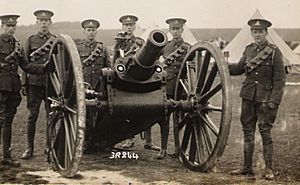
The Territorial Force now had 204 infantry battalions and 56 Yeomanry regiments. These were organized into 14 divisions and 14 cavalry brigades. They also had support troops. A new all-Territorial regiment, the London Regiment, was formed. It included 27 battalions from London. The County Associations raised and managed the divisional troops. Regular army officers commanded the divisions during operations. A Territorial Medical Corps and a Territorial Association Nursing Service were also created.
Once units were transferred, their members had to decide if they would re-enlist in the Territorial Force. By May, 85% of the Yeomanry, 78% of the Artillery, 59% of the Engineers, and 84% of the Infantry units had been recognized. Overall, 28% of the planned strength had enlisted. By June, it was 48%. By the end of 1908, the Territorial Force was at 68% of its planned strength. A popular recruiting campaign in 1909 helped it reach 88%. In 1909, a new Territorial reserve, the "Veteran Reserve," was announced. By 1913, it had almost 200,000 men.
The Militia officially still existed, but 23 battalions that were not needed were disbanded. The 101 battalions that were to be transferred to the Reserves trained as Militia in 1908. But after that, they joined the regular regiments. They formed Special Reserve battalions (usually the 3rd Battalion). By the end of the year, the Special Reserve was at 84% of its strength. Officers and men who did not transfer stayed in the Militia. By January 1913, only 700 of them remained. All transferred battalions were infantry units, except for two Irish artillery units.
A few unusual units were not transferred. These were the two Irish Yeomanry regiments and the Volunteers of Bermuda and the Isle of Man. There were no plans for Territorial Force units in Ireland. So, the two Irish Yeomanry regiments were disbanded and reformed as the North Irish Horse and South Irish Horse in the Special Reserve. The Isle of Man Volunteers and Bermuda Volunteer Rifle Corps remained as Volunteers. The new law did extend to the Isle of Man, but the force there was not reorganized. Bermuda, the Channel Islands, and Malta were not covered by the law. So, the Militia there continued under the old system.
The Act During World War I
The start of the First World War in August 1914 was a big test for the Act and the Territorial Force. The main Expeditionary Force of six divisions was quickly sent to Europe. They faced huge challenges. By Christmas, four-fifths of the original 90,000 soldiers were dead or wounded.
Meanwhile, as Haldane had planned, all 14 Territorial divisions were called up. They were mobilized on time and given weapons. By April 1915, six complete Territorial divisions had been sent to France. The commander of the British Expeditionary Force, Field Marshal Sir John French, said that without the Territorials, it would have been impossible to hold the line in France and Belgium.
Later Laws
The Army (Annual) Act 1909 gave the Territorial Force the power to use private homes for lodging when called up.
During World War I, the Military Service Act 1916 introduced conscription (compulsory military service). This law suspended parts of the 1907 Act. It meant that Territorial soldiers could be moved to different units without their permission.
The Territorial Army and Militia Act 1921 changed the Territorial Force into the Territorial Army. The Special Reserve went back to its old name, Militia. The Air Force (Constitution) Act 1917 created a reserve and auxiliary force for the new Royal Air Force. The Auxiliary Air Force and Air Force Reserve Act 1924 changed the 1907 Act. It allowed County Associations to manage both the Territorial Army and the Auxiliary Air Force. The Auxiliary and Reserve Forces Act 1949 gave County Associations responsibility for the Army Cadet Force.
The Territorial and Reserve Forces Act 1907 was officially ended by the Statute Law Revision Act 1966. In the Republic of Ireland, it was formally ended in 1983 because it was no longer needed after Ireland became independent. In India, it was repealed in 1960.
Today, the main law for the Army Reserve (which the Territorial Army became) is the Reserve Forces Act 1996. Some parts of this law were updated by The Defence Reform Act 2014. This Act also changed the name to Army Reserve.
Images for kids
-
Portrait of Edward Cardwell, driving force behind the Cardwell Reforms, by George Richmond, 1871
-
Erskine Childers whilst serving with an Honourable Artillery Company battery in the City Imperial Volunteers
-
Hugh Arnold-Forster, photographed outside the Palace of Westminster in 1899.
-
One of the new features of the Territorial Force was that its divisions would contain all of their own support units; this field surgery at Gallipoli was an organic part of the 42nd (East Lancashire) Division. Photo by Ernest Brooks.
-
A company of the Liverpool Scottish, a Territorial unit, parading after mobilisation in September 1914
-
A Territorial gun crew with a BL 5 inch Howitzer, at a training camp


